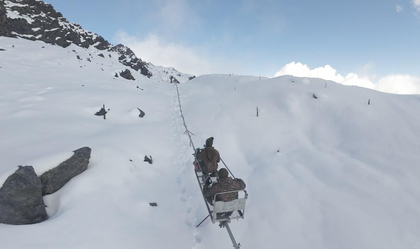Army engineers build indigenous Mono Rail System at 16,000 ft to keep Kameng frontier supplied
By IANS | Updated: November 14, 2025 19:00 IST2025-11-14T18:56:25+5:302025-11-14T19:00:09+5:30
New Delhi, Nov 14 In a major breakthrough for high-altitude military logistics, the Indian Army’s Gajraj Corps has ...

Army engineers build indigenous Mono Rail System at 16,000 ft to keep Kameng frontier supplied
New Delhi, Nov 14 In a major breakthrough for high-altitude military logistics, the Indian Army’s Gajraj Corps has indigenously developed and operationalised a High Altitude Mono Rail System at an elevation of nearly 16,000 feet in Arunachal Pradesh's Kameng sector - one of the most inhospitable and weather-prone frontiers along the Line of Actual Control (LAC).
The Kameng Himalayas are notorious for their sheer, barren cliffs, sub-zero temperatures, violent weather swings, and a rugged landscape that routinely disrupts supply lines. Forward posts often remain cut off for days under heavy snow, while traditional transport methods struggle in the extreme terrain.
Ensuring the uninterrupted movement of essential stores, ammunition, and equipment has remained a persistent operational challenge.
Responding to this pressing requirement, the Gajraj Corps conceptualised, engineered, and deployed an indigenous mono rail system capable of carrying more than 300 kg of load in a single trip.
Designed to function round-the-clock, the system can operate day or night, in hail, storm, or whiteout conditions, ensuring that mission-critical supplies, including rations, fuel, engineering equipment and heavier loads, reach troops without delay.
"It enables reliable movement of mission-critical stores, ammunition, rations, fuel, engineering equipment, and other heavy or awkward loads that are otherwise difficult to ferry across steep gradients and unstable surfaces. This transportation facility is fully operation worthy to be used day or night, with or without escort, during hail or storm, irrespective of the weather conditions," a defence official said.
Its robust, weather-agnostic design allows movement over steep gradients and unstable surfaces where mules, vehicles, and even porters face significant risk.
Beyond its logistical advantages, the monorail system has also demonstrated potential for rapid casualty evacuation.
In several stretches where helicopters cannot land or fly safely, and where manual evacuation is slow and perilous, the new system offers an efficient and safer alternative to move injured personnel.
The development underlines the military’s continued efforts to innovate and excel in extreme environments, ensuring troops deployed along challenging frontiers remain fully supported and mission-ready.
Disclaimer: This post has been auto-published from an agency feed without any modifications to the text and has not been reviewed by an editor
Open in app